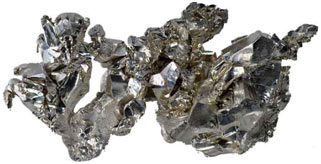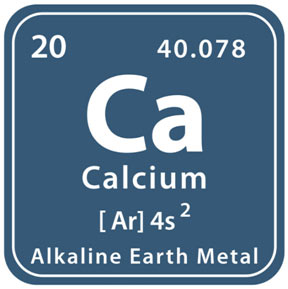Introduction to Calcium Element
Calcium is one of the elements of the periodic table grouped in Alkali Earth metals. Calcium is a structural component and is required by all types of living organisms as well as part of many lifeless components such as corals, soil teeth, etc. It is the fifth most abundant chemical element on Earth and also the fifth most abundant element in the human body.
Naming and History of Calcium
The word calcium is derived from the Latin word “Calx” which means lime.
For centuries, calcium was used for many things and was obtained by heating limestone. Humphry Davy, in 1808 first discovered calcium. He experimented and tried to reduce lime by electrolysis.
He then tried the mixture of lime and mercury oxide and obtained an amalgam of calcium. He then added more lime. In the end, he distilled off the calcium leaving behind amalgam.
Jacob Berzelius performed a similar experiment but was not successful. Antoine Lavoisier called the calcium Earth as it was not reduced further.

Occurrence of Calcium
Calcium is the fifth abundant element in Earth’s crust and cannot be found free in nature. It is reactive so forms a compound by reacting with oxygen and water. it is common in the form of lime and limestone, gypsum, apatite, etc.
Properties of Calcium
In a pure elemental state, calcium is soft, shiny, silvery-white, and the lightest alkali earth metal. When exposed to air, it quickly forms gray-white oxide.
In contact with air, calcium establishes an oxide and nitride coating, which secures it from additional deterioration or corrosion. It burns in the air at a high temperature to produce nitride.
Due to its high reactivity with common substances, there is very little demand for metallic calcium. Calcium carbonate (CaCO3) is one of the common compounds of calcium. It is heated up to form quicklime (CaO) which is then added to water (H2O). This forms another product called slaked lime (Ca(OH) 2) which is an inexpensive base product used throughout the chemical industry.
Uses and Applications
Pure calcium carbonate takes place in two crystalline types: calcite, hexagonal shaped, which possesses birefringent properties, and aragonite, rhombohedric.
The element is crucial for bones and teeth. Calcium assists in the movement of muscles by assisting to bring messages from the brain to all parts of the body.
The ions of the calcium function as carriers between cells in the form of multicellular life kinds.
Calcium helps in assisting hormones to release in addition to enzymes.
This component is extensively utilized in steelmaking due to the fact that it tends to readily form substances with oxygen and sulphur.
Several calcium substances have wide usage in the food industry (as food additives) and the pharmaceutical market.
The metal is utilized in aluminium alloys for bearings, as an aide in the bismuth removal form lead, along with in controlling graphitic carbon in melted iron. It is also utilized as a deoxidizer in the manufacture of numerous steels; as a reducing agent in the preparation of metals as chromium, thorium, zirconium and uranium, and as a separating product for gaseous mixtures of nitrogen and argon.
Calcium is an alloying utilized in the production of aluminium, beryllium, copper, lead and magnesium alloys. It is also utilized in making cement and mortar that are used in buildings.
Gypsum which is dehydrated calcium sulphate is used in Portland cement, making plasters and sculptures. Calcium has a role in maintaining soil properties. As gypsum, calcium has a wide range of applications in agriculture.
Isotopes of Calcium
Calcium has four stable isotopes. These are 40Ca, 42Ca, 43Ca, 44Ca. 97 % of Calcium exists as a 40Ca isotope.
MCQs
- What is the Latin origin of the word “calcium”?
- A) Calor
- B) Calx
- C) Calciumus
- D) Calidus
- Answer: B
- Who first discovered calcium and how was it obtained in 1808?
- A) Antoine Lavoisier, by electrolysis
- B) Jacob Berzelius, by heating limestone
- C) Humphry Davy, by distillation of amalgam
- D) Isaac Newton, by chemical synthesis
- Answer: C
- Where is calcium primarily found in nature?
- A) Free in nature
- B) In its metallic state
- C) In the form of lime and limestone
- D) In gaseous compounds
- Answer: C
- What happens to calcium when exposed to air?
- A) It turns green
- B) It forms a gray-white oxide
- C) It becomes magnetic
- D) It emits a pleasant odor
- Answer: B
- Which of the following is a common compound of calcium?
- A) Calcium oxide (CaO)
- B) Calcium nitride (Ca3N2)
- C) Calcium chloride (CaCl2)
- D) Calcium sulfide (CaS)
- Answer: A
- What is the main use of metallic calcium in steelmaking?
- A) Acts as a catalyst
- B) Forms compounds with oxygen and sulfur
- C) Enhances electrical conductivity
- D) Provides color to the steel
- Answer: B
- Which crystalline forms does pure calcium carbonate take?
- A) Cubic and spherical
- B) Hexagonal and rhombohedric
- C) Tetrahedral and octahedral
- D) Trigonal and monoclinic
- Answer: B
- How does calcium contribute to muscle movement?
- A) By providing energy
- B) By transmitting messages from the brain
- C) By forming a protective layer
- D) By acting as a lubricant
- Answer: B
- What is the primary role of calcium ions between cells in multicellular life forms?
- A) Structural support
- B) Carriers for messages
- C) Energy production
- D) Enzyme synthesis
- Answer: B
- Why is calcium extensively used in steelmaking?
- A) It adds color to steel
- B) It prevents rusting
- C) It readily forms compounds with oxygen and sulfur
- D) It increases flexibility
- Answer: C
- In what industry are several calcium compounds used as food additives?
- A) Automotive
- B) Textile
- C) Food
- D) Electronics
- Answer: C
- What is the main role of calcium in the production of aluminium alloys?
- A) Enhancing color
- B) Deoxidizing agent
- C) Increasing density
- D) Improving conductivity
- Answer: B
- Which isotopes of calcium are stable?
- A) 38Ca, 40Ca, 41Ca, 44Ca
- B) 39Ca, 41Ca, 42Ca, 45Ca
- C) 40Ca, 42Ca, 43Ca, 44Ca
- D) 37Ca, 39Ca, 42Ca, 43Ca
- Answer: C
- What percentage of calcium exists as the 40Ca isotope?
- A) 75%
- B) 85%
- C) 97%
- D) 100%
- Answer: C
- What role does gypsum, a dehydrated calcium sulfate, play in the production of Portland cement?
- A) Acts as a catalyst
- B) Increases strength
- C) Enhances color
- D) Provides flexibility
- Answer: B
- Which industry benefits from the use of calcium as a deoxidizer in the manufacturing process?
- A) Textile
- B) Food
- C) Steel
- D) Electronics
- Answer: C
Wrap up
In conclusion, this tutorial provides a comprehensive overview of the Calcium element, covering various aspects such as its introduction as an Alkali Earth metal, the naming and historical background, occurrence in Earth’s crust, properties in its pure elemental state, and a detailed exploration of its uses and applications.
Additionally, the tutorial delves into the isotopes of Calcium, emphasizing its stability and prevalence.
This information serves as a valuable resource for understanding the significance of Calcium in both natural and industrial contexts, highlighting its crucial role in biological systems, steelmaking, and various other industries.

